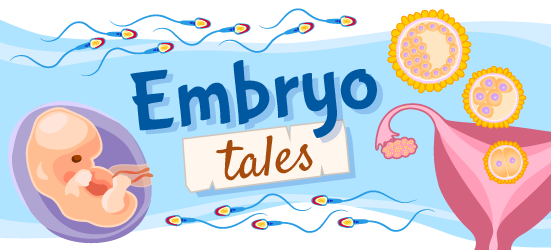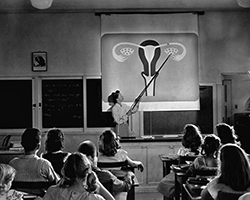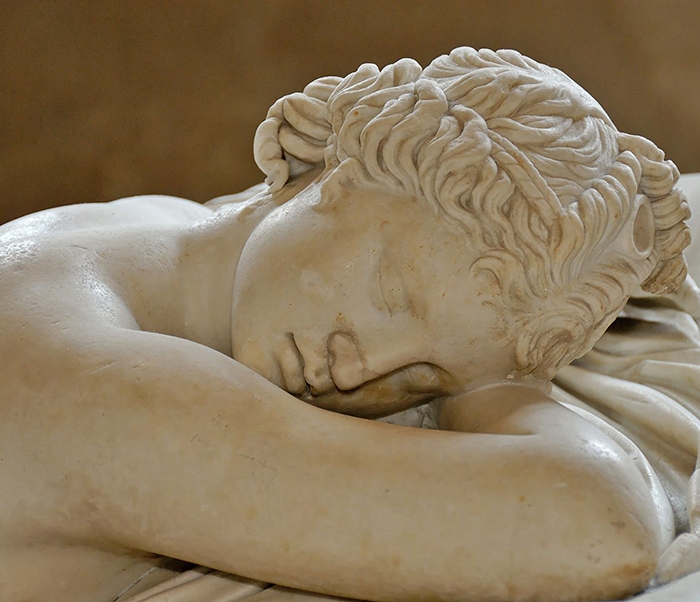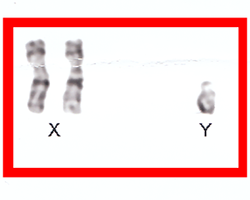
Intersex: More than Male and Female
Illustrated by: Sabine Deviche
show/hide words to know
Advocate: a person who publicly fights for a particular cause; fighting for a cause...more
Androgen: a sex hormone present at higher levels in male bodies that helps form male characteristics...more
Intersex: a term that describes people who are born with both male and female characteristics. Intersex people cannot be strictly categorized as either male or female.
Ovary: creates and stores the female reproductive cells in plants and animals.
Sex chromosomes: a pair of chromosomes many organisms have that decides their biological sex.
Sexual trait (Sexual characteristic): A body part or characteristic that differs based on biological sex. Primary sexual traits are present at birth. They include body parts on the inside and outside of the body that are essential for reproduction. Secondary sexual characteristics are body parts that appear later. Secondary sex traits, such as facial hair, are not required to produce offspring.
Syndrome: a condition that is defined by a group of symptoms that occur together...more
Testis: an organ in the male body that makes male hormones and stores sperm. Testes are usually paired and sit in the scrotum, which is behind the penis.
Morgan walks into the kitchen with a disgruntled look on her face. Her mom notices and asks what’s wrong.
“Today was just awkward. We talked about sex in our health class and learned about the reproductive system.”
“Why was that awkward?”

Many kids learn about their reproductive anatomy in health classes. But intersex kids are not usually well represented in what teachers cover. Image by Tullio Saba via Flickr.
“Well… I know we’ve talked about how my body is different than other girls' in some ways. But it still feels weird to be different than my teacher says I’m supposed to be. Is there something wrong with me?”
Morgan’s mom hugs her. “No, Morgan, not at all! The syndrome you have might make some of your body parts different, but everyone's bodies are unique in some way. Plus, lots of people are born intersex like you. It's completely normal!”
Morgan smiles and hugs her back, “Thanks, mom.”
Morgan has androgen insensitivity syndrome, or AIS, which is one way of being born intersex. About one or two in every 100 people are born intersex in the US. People can develop in many different ways and have a wide range of sexual traits.
There’s nothing weird about being born intersex – it happens in many species. Animals like fish, goats, bears, and yes, humans, can be born with blends of female and male characteristics.
Understanding Intersex
Intersex is an umbrella term, meaning a person can be born with a variety of conditions to be intersex. The characteristics a person has can vary based on what makes them intersex. Let’s learn about some of the conditions that can make people intersex, and how no two intersex people are the same.
Chromosomes Combined
Humans have two kinds of sex chromosomes: X and Y. They each contain different sets of DNA, including instructions for how to make some female or male body parts. The combination of our sex chromosomes largely determines what body parts we are born with.
Typically, people born with female body parts have two X chromosomes, and those born with male body parts have one X and one Y. Intersex people can have XX or XY chromosomes, or other mixes of X and Y chromosomes in various cells. Let’s look at some examples.
Turner Syndrome - X0
About one in every 2000 to 2500 people are born with Turner syndrome. Turner syndrome is when a female has one X chromosome, but either doesn't have a second sex chromosome, or is missing a part of it. As a result, females with Turner syndrome may also have ovaries that are not fully developed. Ovaries create hormones that help with the growth of typically female bodies.
When females with Turner syndrome go through puberty, their breasts may not grow without the help of hormone treatments. Those treatments replace the hormones that female bodies typically make on their own.
Klinefelter Syndrome - XXY
Klinefelter syndrome affects about one in every 500 or 1000 people assigned male at birth. They may have one extra X chromosome, meaning they have XXY chromosomes instead of XX or XY. Typically, they have male genitals. However, they might have a smaller penis and testes, and later could develop breasts.

External genitals can come in a range of shapes and sizes, no matter a person’s biological sex. An intersex person’s body might fall somewhere more towards the middle of the range shown here or might not. There’s no one way that male or female genitalia are supposed to look. Image by Jonathan.Marcus via Wikimedia Commons
Helpful Hormones – Hormones in Balance
People like Morgan can also be born intersex due to differences in hormones. Hormones allow cells to work together to get certain jobs done, like forming body parts.
Let’s look at some of these examples.
Androgen Insensitivity Syndrome (AIS)
One in 20,000 newborns has AIS. Someone born with AIS has XY chromosomes but cannot react to or has only mild reactions to androgens. Androgens are hormones that help the body form male traits.

Many people born intersex experience infertility. That means they struggle to have children. Image by MART PRODUCTION via Pexels.
Some people with AIS have female external genitals, like a body part called the labia. They can also have internal testes at the same time. That is more common in people with Complete AIS. If someone has Partial or Mild AIS, their external genitals can look a little more ambiguous. A person with AIS may take hormone treatments to develop more female or male traits as they go through puberty.
Congenital Adrenal Hyperplasia (CAH)
CAH is when the adrenal glands don’t work properly. Adrenal glands are small organs above the kidneys that make androgens and other hormones. With CAH, the adrenal glands often make excess androgens.
CAH can occur in both XX and XY individuals. XY infants with CAH have male genitals. That’s because in male bodies, androgens typically appear at higher levels. But in XX females, CAH can show up as ambiguous external genitals. For example, a person with CAH may have an enlarged clitoris, which is a small protruding part of female genitals.
Intersex Through Time
A lot of people expect that all bodies fit neatly into easily definable categories of male or female. They may not even know that intersex people exist. But intersex people have been around for as long as humans have.

Alice Dreger is a historian and journalist who was a part of the ISNA for nine years. According to the ISNA, she has become an important part of the intersex rights movement. Image by Dylan Lees Photography granted with permission from alicedreger.com
One Greek doctor and scholar, Hippocrates, who lived around 400 BCE, wrote about the topic. During his time, people may have referred to intersex people as hermaphrodites. In Hippocrates’s way of thinking, hermaphrodites were the perfect balance of male and female on a spectrum. But, Aristotle, a Greek philosopher who lived around 300 BCE, had different ways of thinking. In his view, being a hermaphrodite was “unnatural.”
Aristotle’s view became the more widely accepted one over the following centuries. It reinforced the belief that there are only two valid sexes – male and female – and that are each supposed to look a certain way. Sadly, Western society’s view of intersex people stayed negative in the centuries to come.
Historian Alice Dreger wrote about how in the 1950s, doctors altered intersex children's bodies to make them look more "normal." Doctors often did this with surgeries on the genitals or through hormone treatments. The surgeries or treatments usually happened when these patients were children. That means they occurred without the patient’s permission. Practices like those erased the fact that intersex people exist.
Intersex Advocacy and the Future

On October 26, 1996, people that were a part of the ISNA spoke up about the injustices they faced. They did that at the annual conference for the American Academy of Pediatrics. They pressed for change on the surgeries and treatments done on intersex children. Thus, Intersex Awareness Day is on October 26th. Image by Sparrow (麻雀) via Wikimedia Commons
Parents and doctors may still choose to use such procedures on intersex children. But many advocates have spoken out against those practices. Intersex advocates say that children should have the right to choose their own sexual futures.
In 1993, the intersex advocate Cheryl Chase founded the Intersex Society of North America (ISNA). ISNA fought to get rid of shame around being intersex and to stop doctors from operating on children who can't give consent. The group argued that those interventions can be harmful to the mental and physical health of the child later in life.
Instead, intersex advocates say that children should be allowed to grow up with the bodies they are born with. That way, an intersex person can choose whether they want surgery or not later in life rather than being forced into it. As of 2023, ISNA’s mission is carried on by the organization InterACT: Advocates for Intersex Youth.
As of 2023, people continue to fight against surgeries on intersex children. They also speak out to increase awareness of what being intersex means. Their work helps more people understand that being intersex is just as normal as being male or female.
Image of Hermaphroditus by Jastrow (2007) via Wikimedia Commons.
This Embryo Tale was edited by Megha Pillai and is based on the following Embryo Project Encyclopedia articles:
Cox, T. (2013, December 31). Sex-determining region Y in mammals. Embryo Project Encyclopedia. ISSN: 1940-5030 http://embryo.asu.edu/handle/10776/6887.
Drago, M. (2014, June 5). Androgen Insensitivity Syndrome. Embryo Project Encyclopedia. ISSN: 1940-5030 http://embryo.asu.edu/handle/10776/7899.
Drago, M. (2014, March 14). Frank Rattray Lillie’s Study of Freemartins (1914-1920). Embryo Project Encyclopedia. ISSN: 1940-5030 http://embryo.asu.edu/handle/10776/7644.
Drago, M. (2014, April 9). Hermaphrodites and the Medical Invention of Sex (1998), by Alice Domurat Dreger. Embryo Project Encyclopedia. ISSN: 1940-5030 http://embryo.asu.edu/handle/10776/7818.
Schnebly, R.A. (2021, August 3). Biological Sex and Gender in the United States. Embryo Project Encyclopedia. ISSN: 1940-5030 http://embryo.asu.edu/handle/10776/13338.
Schnebly, R.A. (2021, July 16). Sex Determination in Humans. Embryo Project Encyclopedia. ISSN: 1940-5030 http://embryo.asu.edu/handle/10776/13286.
External Sources:
Alice Dreger, PhD. (n.d.). Intersex Society of North America. Retrieved June 14, 2023, from https://isna.org/about/dreger/
Androgen Insensitivity Syndrome. (n.d).Mount Sinai. Retrieved June 14, 2023, from https://www.mountsinai.org/health-library/diseases-conditions/androgen-insensitivity-syndrome
Congenital Adrenal Hyperplasia. (2022, January 24). Endocrine Society.Retrieved June 14, 2023, from https://www.endocrine.org/patient-engagement/endocrine-library/congenital-adrenal-hyperplasia#:~:text=Congenital%20adrenal%20hyperplasia%20(CAH)%20is,enzymes%20involved%20in%20cortisol%20biosynthesis.
DeVun L. (2018). Heavenly Hermaphrodites: Sexual Difference at the Beginning and End of Time. Postmedieval, 9 132–146.
Diodorus Siculus IV. (n.d). Theoi Classical Texts Library. Retrieved June 14, 2023, from https://www.theoi.com/Text/DiodorusSiculus4A.html#6
Fernandez-Aristi, A.R., Taco-Masia, A.A., & Montesinos-Baca, L., (2018). Case report: Clitoromegaly as a consequence of Congenital Adrenal Hyperplasia. An accurate medical and surgical approach. Urology Case Reports, 18, 57–59.
Intersex Awareness Day. (n.d.). interACT. Retrieved June 14, 2023, from https://interactadvocates.org/intersex-awareness-day/
Intersex People by Country 2023. (n.d). World Population Review. Retrieved June 14, 2023, from https://worldpopulationreview.com/country-rankings/intersex-people-by-country
How Many People Are Affected by or at Klinefelter Syndrome (KS)? (n.d). Eunice Kennedy Shriver National Institute of Child Health and Human Development. Retrieved June 14, 2023, from https://www.nichd.nih.gov/health/topics/klinefelter/conditioninfo/risk
Kikkeri, N. S., Nagalli, S. (2022). Turner Syndrome - Stat Pearls - NCBI Bookshelf. National Library of Medicine. https://www.ncbi.nlm.nih.gov/books/NBK554621/
Seymour, J. (2011). Hermaphrodite. The Lancelet, 377 (9765), 547.
View Citation
Bibliographic details:
- Article: Intersex: More than Male and Female
- Author(s): Risa Aria Schnebly, Riley McInnis
- Publisher: Arizona State University School of Life Sciences Ask A Biologist
- Site name: ASU - Ask A Biologist
- Date published: September 13, 2021
- Date accessed: April 17, 2024
- Link: https://askabiologist.asu.edu/embryo-tales/intersex
APA Style
Risa Aria Schnebly, Riley McInnis. (2021, September 13). Intersex: More than Male and Female. ASU - Ask A Biologist. Retrieved April 17, 2024 from https://askabiologist.asu.edu/embryo-tales/intersex
Chicago Manual of Style
Risa Aria Schnebly, Riley McInnis. "Intersex: More than Male and Female". ASU - Ask A Biologist. 13 September, 2021. https://askabiologist.asu.edu/embryo-tales/intersex
Risa Aria Schnebly, Riley McInnis. "Intersex: More than Male and Female". ASU - Ask A Biologist. 13 Sep 2021. ASU - Ask A Biologist, Web. 17 Apr 2024. https://askabiologist.asu.edu/embryo-tales/intersex
MLA 2017 Style

Be Part of
Ask A Biologist
By volunteering, or simply sending us feedback on the site. Scientists, teachers, writers, illustrators, and translators are all important to the program. If you are interested in helping with the website we have a Volunteers page to get the process started.







